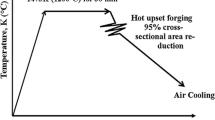Abstract
The structural transitions and tribological properties of carbon-containing high-manganese aluminum-doped austenitic steels tested under different dry-conditions of sliding friction have been considered. The methods used for the structural study of steels are metallography, X-ray diffraction analysis, and transmission electron microscopy. It has been shown that the doping of the studied steels with aluminum taken in the amount of 1.2 wt % significantly increases their resistance to abrasive wear, and especially adhesive wear (up to 20 times). It has been hypothesized that the observed positive effect of aluminum on the wear resistance of austenitic steels is due to the activation of the planar dislocation sliding mechanism, which increases the dispersion of nanocrystals and, correspondingly, the hardness of the surface layer of steels under the conditions of nanostructuring rotational strain by means of friction.





Similar content being viewed by others
Notes
Here and below, the composition is given in wt %.
REFERENCES
F. Maratray, “Nuevas tendendencias para lamejora de los acros austenitticos manganese,” Colada 12 (1–2), 5–11 (1979).
E. Houdremont, Handbuch der Sonderstahlkunde (Springer, Berlin, 1956; Metallurgiya, Moscow, 1966).
Y. N. Dastur and W. C. Leslie, “Mechanism of work hardening in Hadfield manganese steel,” Metall. Trans. A 12A, 749–759 (1981).
Metallography of Iron, Vol. 2: Structure of steels (with micrographs) (Metallurgiya, Moscow, 1972) [in Russian].
I. N. Bogachev and V. F. Egolaev, Structure and Properties of Iron–Manganese Alloys (Metallurgiya, Moscow, 1973) [in Russian].
P. H. Adler, G. B. Olson, and W. S. Owen, “Strain hardening of Hadfield manganese steel,” Metall. Trans. A 17, 1725–1737 (1986).
L. G. Korshunov, “Structural transformations during friction and wear resistance of austenitic steel,” Phys. Met. Metallogr. 74, 150–162 (1992).
L. G. Korshunov, V. A. Shabashov, N. L. Chernenko, and V. P. Pilyugin, “ The effect of contact stresses on the phase composition, strength and tribological properties of nanocrystal structures formed in steels and alloys upon sliding friction,” Metalloved. Term. Obrab. Met., No. 12, 24–34 (2008).
Metal Science and Heat Treatment of Steel: Handbook, In 3 vols., vol. 1, Methods for testing and research (Metallurgiya, Moscow, 1983) [in Russian].
B. K. Zudema, D. K. Subramanyam, and W. C. Leslie, “The effect of aluminum on the work hardening and wear resistance of Hadfield manganese steel,” Metall. Trans. A 18, 1629–1639 (1987).
L. G. Korshunov, A. V. Makarov, and N. L. Chernenko, Friction-Induced Nanocrystalline Structures of in Steels and Alloys, Their Strength and Tribological Properties. Development of Ideas of Academician V. D. Sadovskii (Ekaterinburg, 2008) [in Russian].
E. G. Zakharova, I. V. Kireeva, Yu. I. Chumlyakov, and G. Maier, “Effect of doping with aluminum on the mechanisms of strain hardening of single crystals of austenitic Hadfield steel,” Fiz. Mezomekh. 7, Special issue, Part 1, 233–236 (2004).
L. G. Korshunov, Yu. N. Goikhenberg, N. A. Tere-shchenko, A. I. Uvarov, A. V. Makarov, and N. L. Chernenko, “Wear resistance and surface structure of nitrogen-containing stainless austenitic steels upon friction and abrasive wear,” Phys. Met. Metallogr. 84, 554–561 (1997).
V. Gerold and H. P. Karnthaler, “On the origin of planar slip in F.C.C, alloys,” Acta Metall. 37, 2177–2183 (1989).
L. G. Korshunov, Yu. N. Goikhenberg, and N. L. Chernenko, “Effect of silicon on the structure, tribological behavior, and mechanical properties of nitrogen-containing chromium–manganese austenitic steels,” Phys. Met. Metallogr. 96, 535–544 (2003).
ACKNOWLEDGMENTS
Electron microscopic study was performed in the Department of Electron Microscopy of the Shared Facilities Center “Testing Center of Nanotechnologies and Advanced Materials” of the Mikheev Institute of Metal Physics of the Ural Branch of the Russian Academy of Sciences.This work was performed under the state task of the Federal Agency for Scientific Organizations in the program “Structure” (project no. 01201463331) with partial support from the Ural Branch of the Russian Academy of Sciences (project no. 18-10-2-39).
Author information
Authors and Affiliations
Corresponding author
Additional information
Translated by E. Glushachenkova
Rights and permissions
About this article
Cite this article
Korshunov, L.G., Chernenko, N.L. Effect of Aluminum on the Structural Transitions and the Wear Resistance of Hadfield Steel under Friction. Phys. Metals Metallogr. 119, 700–706 (2018). https://doi.org/10.1134/S0031918X18070050
Received:
Accepted:
Published:
Issue Date:
DOI: https://doi.org/10.1134/S0031918X18070050



